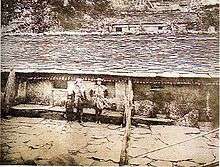Ushinosuke Mori
Ushinosuke Mori (森 丑之助 Mori Ushinosuke, January 16, 1877 - July 4, 1926) was a Japanese anthropologist and folklorist. He studied the aborigines of Taiwan.
Early life
Mori was born in Kyoto. Following his graduation from Kumamoto Chinese school, in 1895 Mori went to Taiwan as a Chinese language army interpreter during the Sino-Japanese war. He had expressed his desire to contribute to Japanese scholarship by studying the peoples of Taiwan.[1]
Career
For nine months in 1900, he participated in research as an interpreter and guide with anthropologist Ryuzo Torii of the University of Tokyo. From April 1908 to September 1910 he was commissioned to an old customs committee. By 1924, he was recorded as employed by the Governor-General of the National Taiwan Museum. While there, he conducted a survey of aboriginal residential districts throughout Taiwan.
Over the course of twenty years he built a collection of survey records, created numerous video recordings and photographs (some of which are on display in the National Taiwan Museum),[2] and established a language laboratory. His work included over 100 scholarly articles.

In addition to its effect on other anthropologists, Mori’s work had some influence in the arts. For example, Chinese sculptor Huang Tushui was able to sculpt figures with Taiwanese features without having direct contact with the people themselves because he had access to Mori’s images.[3] And the author Haruo Satō gained personal insights directly from Mori himself which were later incorporated into his realistic literary depictions of aborigines.[4]
Mori also discovered many alpine plants and named more than 20 species. Among these species were Berberis aristatoserrulata and Berberis brevisepala, discovered in April 1910 on the Qing Dyansty Trail of the mountain of Guanmen-Shan. Although these two species were published in 1913 by Japanese botanist Bunzō Hayata, no botanist visited Guanmen after Mori until 2014, when an international expedition of botanists and hikers trekked there in an attempt to discover more about them. Guided by notes left behind by Mori, the expedtion was successful and both species were found on the mountain trail.[5]
He put forth the idea of "The Aboriginal Paradise" as an autonomous region for the aborigines with the idea to bring about peace between aborigines in Japan and in Taiwan. In 1923 Mori was devastated by the Great Kanto Earthquake, causing him to lose most of his research.[6]
In July 1926, he disappeared in a boat returning to Japan. He committed suicide at sea at age 49.[7]
Bibliography
- 台灣番族圖譜
- 台灣番族志 (unfinished)
References
- ↑ Tropics of Savagery: The Culture of Japanese Empire in Comparative Frame, p. 85-86, at Google Books
- ↑ Morris, Andrew D. Japanese Taiwan: Colonial Rule and its Contested Legacy. p. 70.
- ↑ Lai, Jen-Yi (2008). Cultural Identity and the Making of Modern Taiwanese Painting During the Japanese Colonial Period (1895--1945). University of Michigan: ProQuest. p. 100. ISBN 0549986472. Retrieved 26 November 2016.
- ↑ Exley, Charles (2016). Satō Haruo and Modern Japanese Literature. Brill. p. 118. ISBN 9004309500. Retrieved 26 November 2016.
- ↑ Harber, Julian (2014). "Berberis in Taiwan" (PDF). International Dendrology Society. pp. 49–57. Retrieved 26 November 2016.
- ↑ "The Slow Ship Back to Taiwan: Mori Ushinosuke, a Man Who Cared About Taiwanese Aborigines". culture.teldap.tw. Retrieved 2016-09-16.
- ↑ "The Slow Ship Back to Taiwan: Mori Ushinosuke, a Man Who Cared About Taiwanese Aborigines". culture.teldap.tw. Retrieved 2016-09-16.
External links
- Digital Museum of Taiwan Indigenous Peoples
- 呉蜜察 監修 遠流台湾館 編著 (2000), 台灣史小事典, 円流出版公司, p. 138, ISBN 957-32-4161-7
